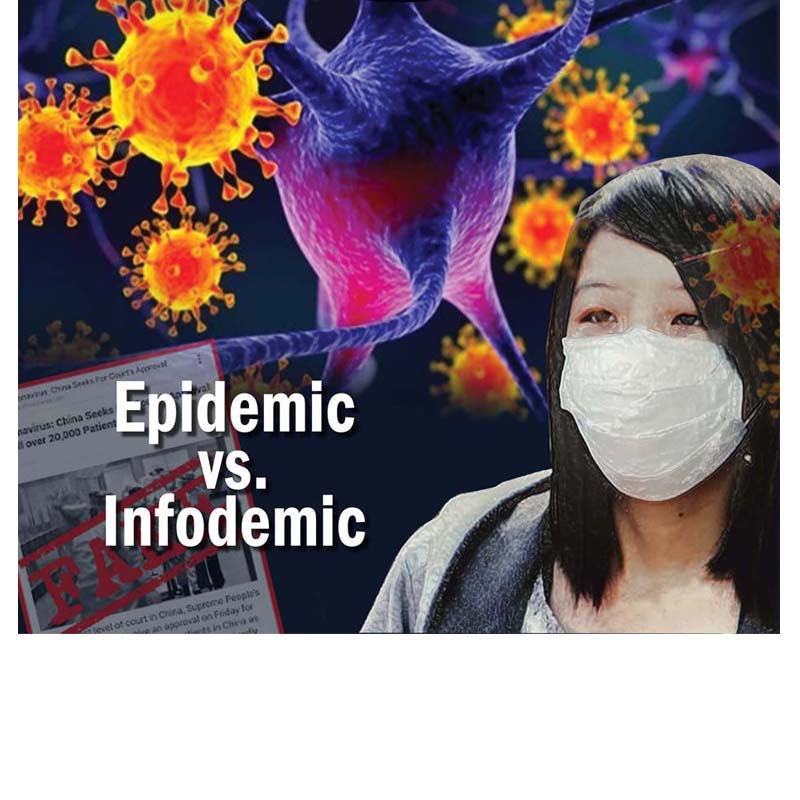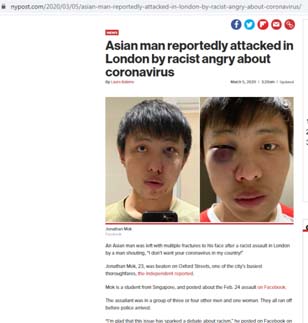Hoaxes related to the COVID-19 health crisis are turning people against each other, causing panic when calm is needed. As such, the current COVID-19 crisis is not just a global pandemic, it is also now a global infodemic.
Some of the results have been unfortunate:
- China and Chinese bashing;
- people being beaten up because they were mistaken for being Chinese;
- mindless panic buying, leading to scuffles when shoppers fight over such mundane items as toilet paper;
- people doing things that they normally would not do, and causing themselves harm, such as drinking chlorine or snorting cocaine in the belief this would protect them from the killer virus;
- an American television news host fuels rascism against China over the coronavirus outbreak, leading to a Chinese newscaster publicly demanding an apology.
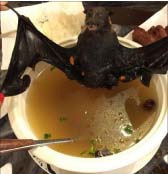
And the list goes on.
In many social media posts, there are jokes about how a strain of COVID-19 has mutated, with one major symptom added: stupidity. At the start of the outbreak last January fake news spread faster than the virus itself (many of these were definitely not funny). Some fake news were easy enough to spot and can just as easily be dismissed.
More difficult to mitigate are the seemingly authoritative information that are bogus after all. Some appeared to be logical and people indiscriminately passed them on. The more the fake news spread, the more it becomes coated with a semblance of truth.
Let’s start with the very first viral story on the source of COVID-19: bats.
In early January, social media and traditional media news outlets covered and revealed that the novel coronavirus might have come from eating bats, complete with alleged photographic and video “evidence.”
Soon, however, the photographs and videos of people eating bats were exposed to have originated from outside China, Palau in 2016, to be exact and none have links to the epidemic. It was a tourism promotional information on where in Palau to get the best bat soup, specifically from fruit bats.
Why did they seem so real and true? Because there is science involved. Diseases do transfer from animals (mammals) to humans – ebola, mad cow disease, swine flu. Bats do carry a form of coronavirus, and were confirmed as the source of the SARS (Severe Acute Respiratory Syndrome) epidemic in the early 2000s.
At first, experts were looking at bats as the source. Reputable media outlets were careful in stating that experts “were considering bats as the source.” But others, including social media, already branded bats as the source and told everyone how disgusting the Chinese were for eating bats.
The videos seemed believable because three of them showed Chinese having bat soup. One was from a Chinese social media influencer. Instead of finding out if the videos were true or not, if they were connected to the coronavirus or not, netizens simply went haywire bashing the Chinese woman. When she found out, she quickly responded that the video was taken in Palau in 2016.
Another was from a student at the University of Wuhan. As soon as her video went viral, she deleted the originals from her account and added a phrase to her profile, “Stop being idiots; these videos are from last summer.”
The third is of a man explaining how to eat bat meat. The fourth is of a Filipino couple supposedly having bat soup in Wuhan. This had an added shock value for audiences in the Philippines because they were speaking in Tagalog. Again, both videos were taken in Palau.
And here’s the rub. That news bit on bats was the first of many other “news” that spread throughout the world without being verified.
Deadly posts
More dangerous are fake posts that:
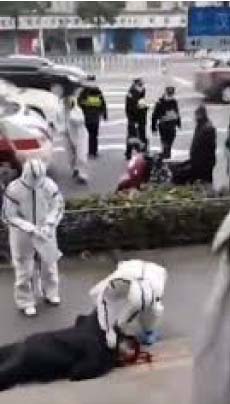
- People in China are falling down dead in the streets;
- Bodies are piled high side by side with the sick;
- Policemen are shooting down sick people in the streets.
The first video of a man falling down in the sidewalk was taken from the news a few years ago of a heart attack patient keeling over. Doctors debunked the video, that viral illnesses do not kill instantly, much less make you fall down dead. Only a massive heart attack causes that.
The second video was supposedly taken at a hospital, but the video did not show that the patients in the beds in the crowded hospital were dead.
The third video was especially vicious. It showed two policemen approaching a guy, and then an ambulance speeding off. It was proven to be a composite of three different incidents in three different areas.
It worried Chinese authorities considerably because they knew that anti-China people are deliberately spending time and resources to hit China when the country was at its most vulnerable.
Here on the home front, texts and viber messages spread like wildfire. More than that, the messages carry more damaging sentiments than just the virus itself. It seems that people have just become trigger happy with the “share” and “forward” buttons.
When a patient was diagnosed positive at the Cardinal Santos Medical Center in San Juan, the ending of the news included “avoid Cardinal.”
This is downright irresponsible. Hospitals follow protocols from the Department of Health and the World Health Organization. We should trust in them and our health workers to help us pull through this crisis.
Another viral Viber message said: “The first COVID-19 positive patient in Quezon City came from the area around (a shopping mall)… avoid going to that mall and to a certain sports club because the patient went swimming there.”
Conspiracy theories abound.
The Pro-China senders say the virus is a United States bio-weapon spread into China by drones. On the other hand, the anti-China people say the virus is a bio-weapon from a Wuhan laboratory that leaked out.
There is also a profusion of false claims about the number of fatalities, unconfirmed information about where infected individuals are living, text messages that lure users to click on supposedly informative links that are actually scams.
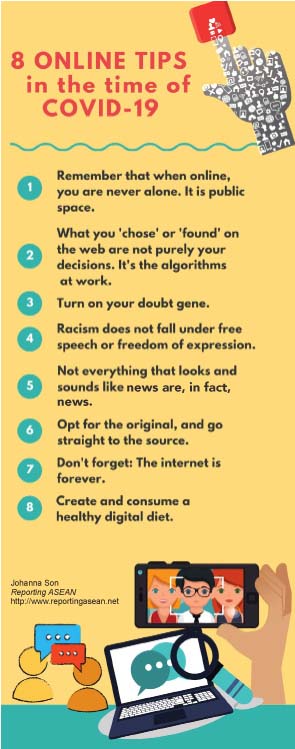
In early January, the National Capital Region ran out of face masks: N95 in reaction to the Taal Volcano eruption and surgical face masks as the news of the coronavirus spread.
Meanwhile, prudence dictated that not wearing masks and washing hands often were a better way to keep safe. With the dearth of masks, people tended to wear them the whole day, when they had to be changed every eight hours and more often during hot weather.
Wearing one for an entire day turns it into a breeding ground of bacteria and viruses from yourself and others. Furthermore, many people are not careful in removing the mask. They touch the facial part instead of the straps.
That means whatever viruses were on it transfer to hands and to the self. Fortunately, Covid-19 has not yet spread to the Philippines at that time. The hubbub on masks died down and people became more careful in distancing themselves from crowded places and avoiding beso-beso greetings.
So far, the most authoritative news come from Dr. Edsel Maurice Salvana, an infectious disease specialist at the Philippine General Hospital, Manila. His regular bulletins responded succinctly to all the unfounded claims people make.
One of the latest bulletins explained that the additional diagnosed cases did not indicate community transmission yet; the DOH was not underreporting cases, and that yes, we could possibly be missing cases, because even the best surveillance in the world can miss cases.
This is where the lengthy explanation on how hospitals follow DOH and WHO protocols are to be commended and trusted. He clearly outlined the steps hospital professionals take to diagnose and isolate a suspected COVID-19 case.
He ended with an explanation on how doctors arrive at a diagnosis and how it is not possible to test every person who just wants to be assured. The clearly defined process helps allay fears and rumors of incompetence or lack of transparency.
Now, the best advice is to wait for official sources to release news. If you want to take it a step further, verify and corroborate the information yourself. Let us believe evidence, and not unverified rumors.
Racism gone awry
These days, the concern is for more legitimate news and corroborating evidence. This is a huge step up from the furor of racism at the beginning of 2020.
When news about the novel coronavirus in Wuhan City came out and that bats were a likely culprit, the scientific investigation quickly spiralled down to racist rants. Members of Kaisa Para Sa Kaunlaran and our volunteers were putting out racism-related fires that were in social media last January and February.
Some of the worst comments included “China deserved it,” that getting an epidemic was just karma for them, because they were greedy in claiming our territories in the West Philippine Sea. When I started reading these, I was shocked by how a Christian nation could wish another people ill.
A video of a man lying in a Manila street went viral. The one taking the video said the man was a Chinese and had coronavirus and was too ill to stand up but no one dared approach him. When the man stood up unassisted later, it turned out he was Korean and drunk.
In the southern city of Cagliari, Italy, a 31-year-old Filipino was hospitalized. He said he was attacked by a group of young men who thought he was Chinese and accused him of “bringing the virus” to Italy. Singaporean student Jonathan Mok, 23, was attacked in London by four men who made racist remarks.
Let us fight the virus, not the Chinese. Viruses are beyond race and boundaries.
Scientists are now hypothesizing that China may not be the only source of COVID-19 and that some of the more than 8,000 incidence of death supposedly from the common flu in the US in 2019 may in fact be from COVID-19. This emphasizes that viruses can happen anywhere. People have to fight collectively against the disease and need not waste energy and resources fighting racism.
As anti-crime crusader and Tulay columnist Teresita Ang See said last January: “The ‘you vs us’ attitude, finger pointing, racism – is deadlier and cause more permanent damage than the virus we are now fighting collectively as one humanity. There is no room for divisiveness. Viruses know neither race nor boundaries; so to stop it from spreading, helping the afflicted should be our primordial task. Stop the hatred and animosity; use our energies and resources in helping those in dire need. It is the only civilized and Christian thing to do.”
